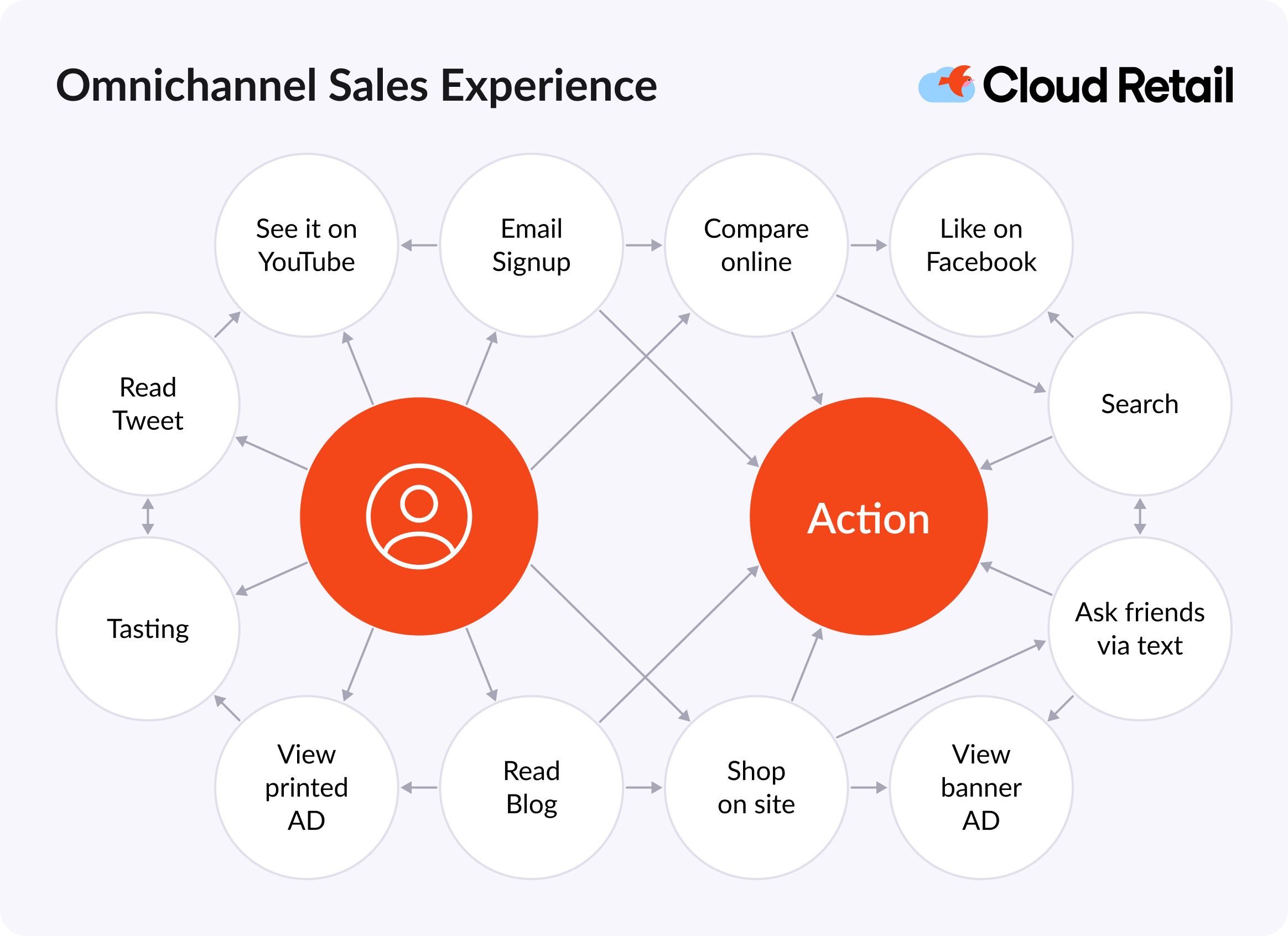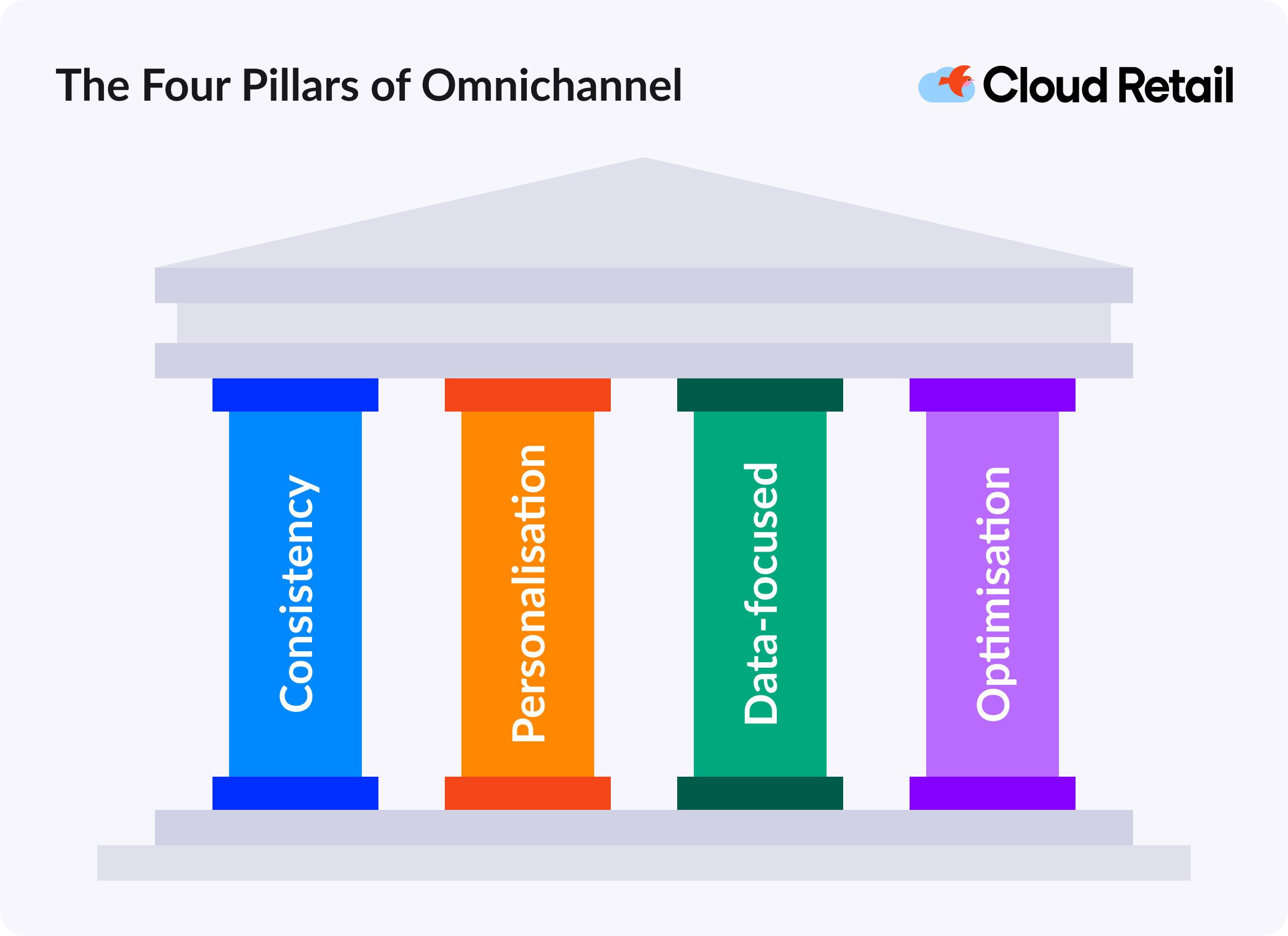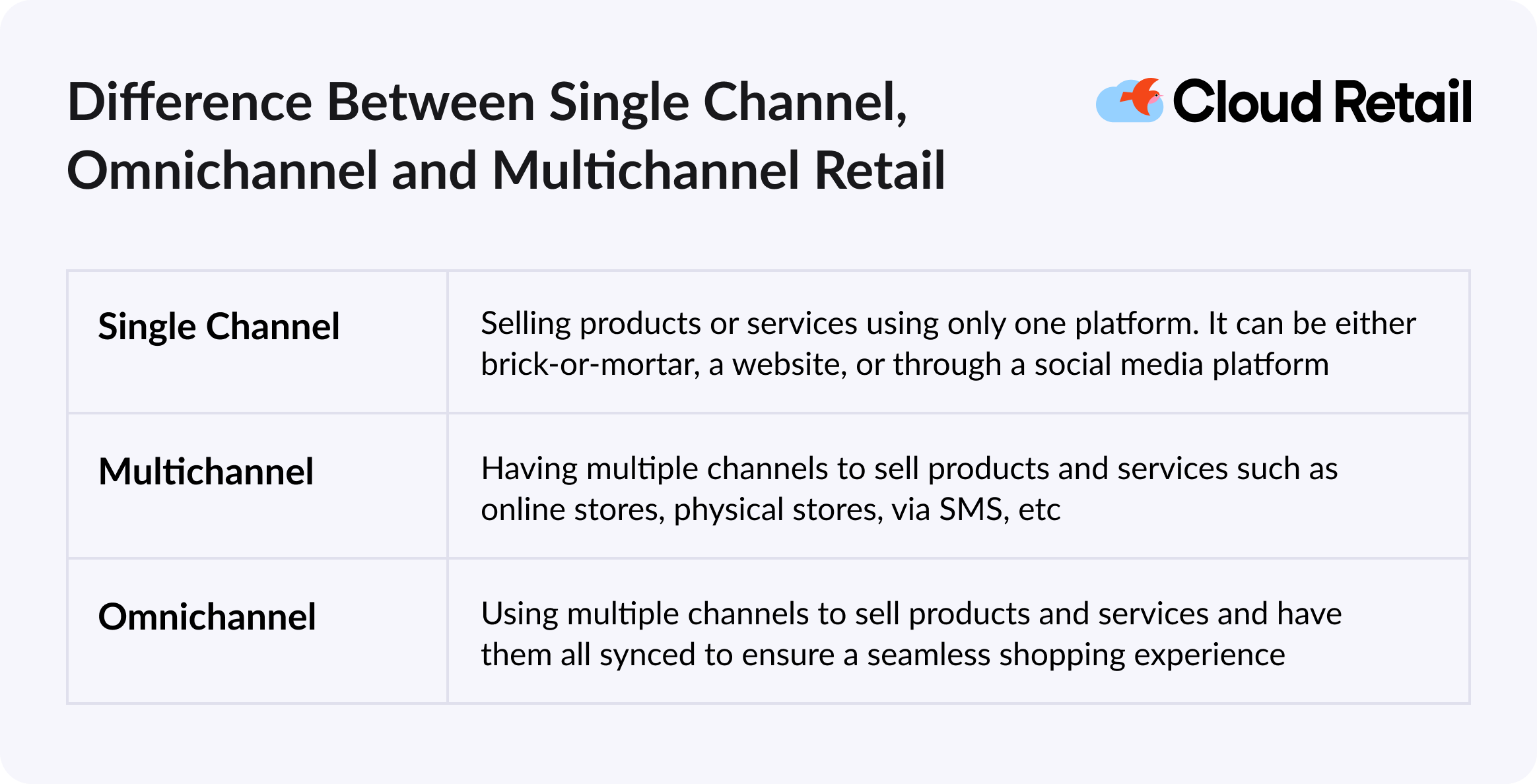Reading time: 15 min
In a 2022 Salsify Report, respondents said they engage across 11 touchpoints before purchasing. It indicates how crucial omnichannel experiences are for winning customers regardless of platform.
In simple words, omnichannel means interacting with customers on a platform that is most convenient to them - brick-and-mortar, digital storefront, social media sites, apps, or other mediums.
At the same time, only being present everywhere is not enough. To make the omnichannel presence fruitful, сompanies need to identify how their customers behave at each touchpoint and tailor marketing efforts accordingly while keeping precise track of performance.
This comprehensive guide covers the benefits, examples, techniques, and everything about omnichannel sales and marketing.
What is Omnichannel Sales?
Omnichannel sales is an integrated marketing approach that aims to provide a fluid and seamless experience to consumers, irrespective of the channel. Be it mobile, in-store, metaverse, apps, apple-watch or any other touch point, the brand should create a convenient, cohesive, and synergistic user experience at each end.
Suppose Irene browsed a brown tote on an ABC brand’s Facebook page. Now, when she opened her Instagram, there was the same bag. She again checked it out and, this time, added it to her cart and left it there.
Now, she opened her email and got a reminder of the abandoned cart; ultimately, she made a purchase, which she chose to pick up in-store. This is what truly is called an omnichannel sales experience.

The Four Pillars of Omnichannel

Omnichannel doesn’t mean companies bombard their potential buyer from the left, right, and the centre. Brands aim to ensure their omnipresence is laser-focused and highly optimised. This involves structuring their processes to utilise the right tools and techniques, thereby providing a unified, relevant, and unique experience across each platform, without confusing customers.
Here are the four pillars on which omnichannel strategies are based:
- Consistency: In-store or online, customers should feel they are interacting with the same brand regardless of where they are.
- Personalisation: It is essential to communicate with prospects in a tailored and personalised way. Thus, they’ll feel more compelled to take action.
- Data-Focused: Omnichannel is about making each move based on the concrete data collected across multiple platforms. For instance, what customers click most and what’s in trend.
- Optimisation: Today it’s not enough to make a single post and shoot it across Facebook, Instagram, Twitter, and wherever a company has presence. The key is to optimise messages according to the platform—for instance, a reel for insta or a long-form post for Facebook.
What’s the Difference Between Single Channel, Omnichannel and MultiChannel Retail?

What’s the Difference Between Omnichannel and Multichannel Marketing?
Both concepts might sound the same to someone new to marketing; however, there is a huge difference between omnichannel and multichannel strategies and the experience they create for the customers. Here’s how:
Multichannel Marketing
In multichannel marketing, businesses have several platforms to interact with customers at multiple ends, but they might not offer the same stuff at all points. Moreover, not all of these platforms need to complement each other.
Here is an example: а customer bought something online and wants to return it to the nearest store. If the store refuses to return the product, that means the brand has not integrated all of its channels to provide the same level of service.
Most brands use a multichannel approach as they find it more convenient to manage. The focus is mainly on reach and easier operations, whereas the customer experience has to take the back seat often.
Omnichannel Marketing
Omnichannel marketing, on the other hand, is highly focused on customer’s needs and convenience. It prioritises customers and takes all the measures to satisfy their evolving buying needs.
For instance: If a customer learned about a promotion through an SMS, now they can visit a physical store or website to discover more offerings. They can even make a purchase online and visit the physical store at their convenience to pick up the product.
According to statistics, purchase frequency is 250% higher on omnichannel vs. single channel. Therefore, the brands that invest in omnichannel strategies tend to grow and retain customers way more than multichannel or single-channel approaches.
Five Key Benefits of Omnichannel Marketing
Investing in an effective and optimised omnichannel marketing strategy yields the following results:
1. Enables Customer Retention
Omnichannel strategies are more likely to create a better customer experience, which is the key to customer retention. As per an Omnisend report, customer retention rates are 90% higher for omnichannel than for single channels.
Customers who use multiple channels to engage with a brand tend to spend more time with it. When they feel they are being facilitated in every possible way, they trust the brand to the extent that they build an emotional bond.
When this trust is built, they are more likely to return to the brand and refer to others, uplifting its reputation even more.
2. Lessens the Risk of Static Inventory
Relying on a limited number of marketing channels means a higher risk of stagnant inventory sitting idle for long periods. Omnichannel marketing strategies ensure customers reach the brand from all the possible touchpoints.
If one channel experiences a high product demand, the brand can promptly respond by allocating stock from other channels. By doing so, the inventory is always balanced across the channels.
Also, different channels may experience a significant shift in demand depending on seasonal factors or special promotions. The omnichannel approach also allows the business to quickly adapt to such variations so that the products are effectively moved to generate revenue and enhance profitability.
3. Keeps Ahead of Competition
According to Aberdeen Group, companies with strong omnichannel strategies observe a 9.5% consistent growth in annual revenue, compared to 3.4% for weak omnichannel companies. By ensuring a smooth and personalised experience, you can stay ahead of the intense market competition.
Brands with an omnichannel approach constantly upgrade and refine their sales efforts to satisfy customer needs in the best possible manner. Consequently, the brand gets a competitive edge by making the shopping experience as convenient as possible.
4. Facilitates Shoppers During Cross-Platform Interaction
As per statistics, around 40% of buyers commence their buying journey with a broad search. This means before making a purchase, they prefer to hover from one channel to another to gain a thorough insight into the brand and the product they are interested in.
Keeping this particular customer behaviour in mind, businesses with an omnichannel approach create a brand ecosystem by utilising multiple touchpoints. Leveraging this framework, the brands can proactively address customer queries and concerns throughout their buying journey.
All these efforts collectively build a cross-platform network that keeps shoppers engaged with the brand no matter where they are on the online or offline spectrum.
5. Empowers Personalised Customer Interaction
When it comes to establishing omnipresence, customer data is like a gold mine. Leveraging this information, brands can tweak and tailor marketing efforts to cater to unique customer needs.
Going for an omnichannel approach is similar to evoking a chain reaction. The more you interact with your customers using multiple channels, the more customer data you capture.
Data allows to segment the target audience more efficiently and create a hyper-focused campaign, ultimately leading to a more personalised customer experience.
Prominent Examples of Omnichannel Marketing
Need real-life examples of how brands have successfully implemented an omnichannel strategy? Let's look at TopShop and Amazon's omnipresence in the digital and physical space.
TopShop
TopShop - now owned by ASOS - launched an interesting campaign as part of London Fashion Week. The campaign interestingly combined the most traditional advertising technique with one of the most advanced ones.
The company installed a series of billboards synced with the company’s Twitter account. Each time someone tweeted about TopShop with the hashtag #LFW, the billboard would display the tweet along with a relevant item.
The captivating campaign encouraged more people to engage with the brand, making this campaign a success.
Amazon
Amazon’s omnichannel strategy is a masterclass for creating a first-class omnichannel experience. They have introduced Amazon Prime Membership, a single incentive to create an account and log in regardless of channel and device.
It comes with a plethora of benefits for buyers, including fast shipping, prime wardrobe and other discounts. At the same time, it enables data unification, which makes it easier to study customer behaviour for the brand.
Owing to this unified data, Amazon efficiently keeps track of customers’ preferences and ultimately formulates a successful omnichannel strategy.
Moreover, the company has gadgets like Echo that let you talk and buy with ease. Besides, its website and app sync with customers' carts whenever they sign in, encouraging them to resume buying.
How to Create an Effective Omnichannel Campaign?
1. Identify Where Сustomers Spend Most of Their Time
The key to a successful omnichannel presence is to pinpoint where customers are accustomed to spending most of their time, making purchases, or exploring products. The best practice here is to take the guesswork out of the process and use legit monitoring tools such as
- Google Analytics
- Customer Relationship Software
- Social Media Monitoring tools, and the list goes on.
Data on the effectiveness of various channels enables companies to make informed decisions about where to invest resources. This strategic allocation ensures that customers can conveniently shop and interact with the brand in their preferred environments.
2. Segment Customers in Different Sections
As discussed above, personalisation is pivotal to omnichannel marketing. The first step in this direction is to segment the customers into distinct groups.
For example, segmentation can start with such basic criteria as:
- Income range
- Age
- Online behaviour
- Interests and values
- Geographic region
How does this segmentation help? To illustrate, if you sell organic skincare, audience segmentation helps you be laser-focused on the audience whose values align with the value of your products, i.e, natural, organic skincare products.
Leveraging the customer data, you can present customers with tailored product recommendations, emphasising more on organic ingredients.
3. Make Shopping Effortless Across All Channels
According to a study by SDL, 90% of customers expect consistent interactions across channels. Therefore, the one who wins the competition is the one who ensures a highly uniform buying experience at all points, just like Starbucks.
Buying with Starbucks, you can either pre-order, pay via the app, or order online and pick up in-store.
4. Train All Team to Engage with Customers at Each Platform
Customer interaction is pivotal to establishing an omnichannel strategy that works. The goal here is not only making each point shoppable but also making each point as “human” as possible.
As per stats, when customers have a good experience with customer service, 89% of them are more likely to buy from the same brand again. Therefore, companies educate their staff about how customers can switch from one platform to another.
And how should this switching behaviour be addressed so they are not lost in the transition? The key is to make their experience as smooth as possible, which can be effectively done using an amalgamation of tech tools and human support.
What are some of the latest Omnichannel marketing trends?
QR Codes to Direct Customer Online
QR codes are a great way to direct customers from offline to online. Brands are utilising QR codes at in-person events to send traffic to their online platforms and encourage people to purchase more online.
Blending In-Store and Online Experiences
Many brands are adopting a fluid shopping approach. Owing to this, customers can make a purchase online and buy in-store. Or they can buy it in-store and ship it to their address. Whether from the couch or in a physical store – it’s all about enabling a stress-free shopping experience.
Virtual Try-Ons Using Augmented Reality
Virtual try-ons are highly beneficial in the beauty industry, allowing customers to match the right products to their skin tone and style. To some extent, this provides an offline experience in the online space where customers can see tangible results in the eCommerce environment and make an informed buying decision.
Voice Shopping with Voice Assistants
Studies prove that online shoppers using voice assistants tend to spend an average of $136 more on their purchases than those who just click and browse to buy. Fortunately, mobile devices are the low-hanging fruit for voice technology, as there is no need to buy extra equipment to enable this feature. Owing to this, more brands are leveraging voice-enabled mobile apps and voice AI kiosks in retail stores to enhance customer experience.
Omnichannel Attribution: What Role Does it Play in Your Omnichannel Marketing?
Now that we have gone through the benefits, best practices and trends of omnichannel marketing, it’s crucial to know that your omnichannel strategy will be as good as your data collection and then optimisation accordingly. This is where omnichannel attribution comes into play.
Omnichannel attribution allows you to measure the impact of each touchpoint across multiple channels and devices where your audience engages with your brand. Measuring this impact opens a deep insight into your customer journey and, most importantly, return on investment.
Thanks to this attribution, marketers are more aware of which channel has good traffic and where you should focus your attention the most.
Here is a breakdown of tools that help collect and analyse attribution data.
1. Website Traffic Analytics: Website analytics tools like Google Analytics, Google Search Console, and Adobe Analytics are great for gaining insights into website visits, customer behaviour, bounce rate, sources of traffic and much more.
2. Cross-Device Tracking: This helps determine how a customer switches between the devices (smartphone, tablet, laptop) before making a purchase.
3. Customer Relationship Management Software: Tracks customer interactions and keeps a record of when customers asked a question, made a purchase and which campaign convinced the customer to make a purchase.
4. Cookies, Tags, UTM Codes: All these tracking mechanisms track the performance of marketing campaigns and also keep tabs on how prospects interact with your brand. For instance, UTM identifies where the buyer came from or whether an ad brought them to the site.
How Cloud Retail Can Help Craft a Winning Omnichannel Strategy?
Need a polished eCommerce solution that complements your omnichannel efforts? Cloud Retail is a white-labelled software provider that caters to many retail niches.
More and more people are turning to mobile apps for their shopping and service needs, reflecting a growing trend of a mobile-first approach. And it's crucial to note that we have an application that enables this. Our app plays a key role, providing a comprehensive omnichannel experience.
The ready-to-use eCommerce platform not only enables seamless integration for inventory, product information, and customer data synchronisation across platforms, but also incorporates a Catalogue and Order Management System. This system is adept at managing catalogues and inventory, ensuring consistency across all sales channels, be it an app, website, various marketplaces, or social media. Additionally, the platform enhances efficiency in assembling and fulfilment. If shipments are handled in-house, orders are processed through a unified system, simplifying the workflow and reducing the need for staff to navigate different custom processes for each source.
Cloud Retail emphasises real-time analytics, helping you gain a thorough insight into customer engagement, behaviour and preference. Using this insight, you can tailor your efforts, products and offerings accordingly.
Lastly, providing software, Cloud Retail goes the extra mile to help businesses with technology implementation, consulting services, and assistance, maximising revenue in a diverse eCommerce landscape.
Want to explore more? Request a demo now to discover how you can revolutionise your ecommerce and propel your business toward omnichannel success.
